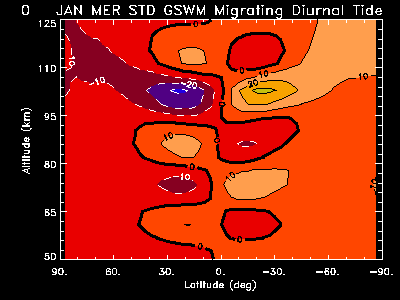
Animation cycles three times (three solar days). [ESC] to stop, Reload to replay.

Note the peak between 100-110km and the diminishing amplitude elsewhere (due to the denser atmosphere at lower altitudes, and gravity wave stress at higher altitudes). The tide is not strongly driven near the poles.
The phase of the tide differs by 12 hours across the equator, so the maxima in opposite hemispheres at a given altitude and time occur in the opposite directions.
Contrast with the diurnal zonal tide (April case), which has the same phase across the equator and is therefore more symmetric. Note the strength of this diurnal tide near the equator in a latitude vs. longitude "top view" at 100km (April).
See how the phase difference across the equator of 1/2 of a period persists even in the different structure of the semidiurnal meridional tide (January).